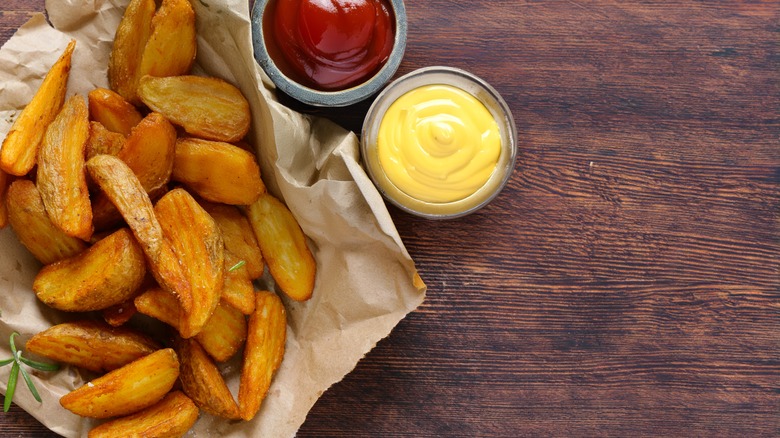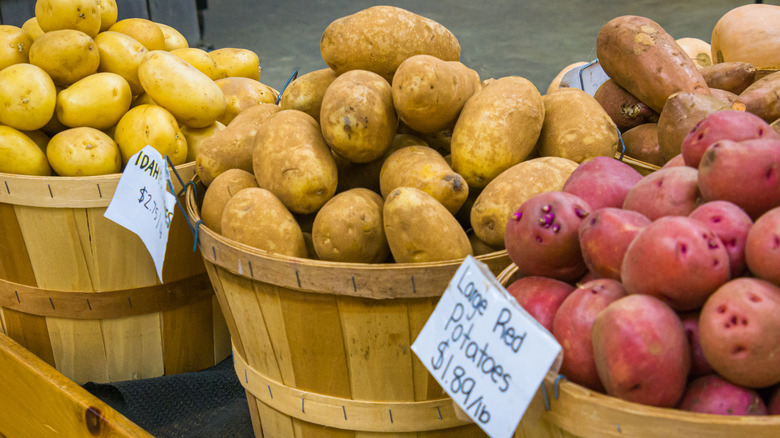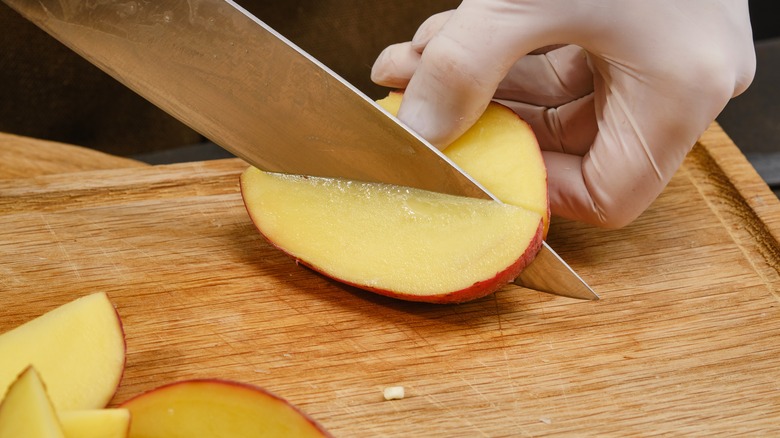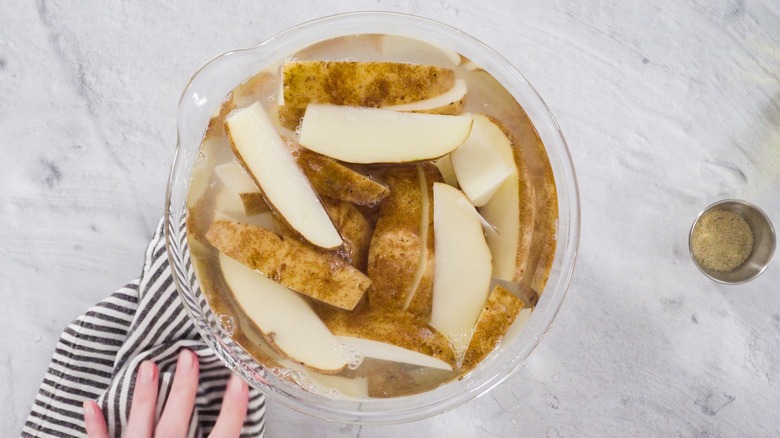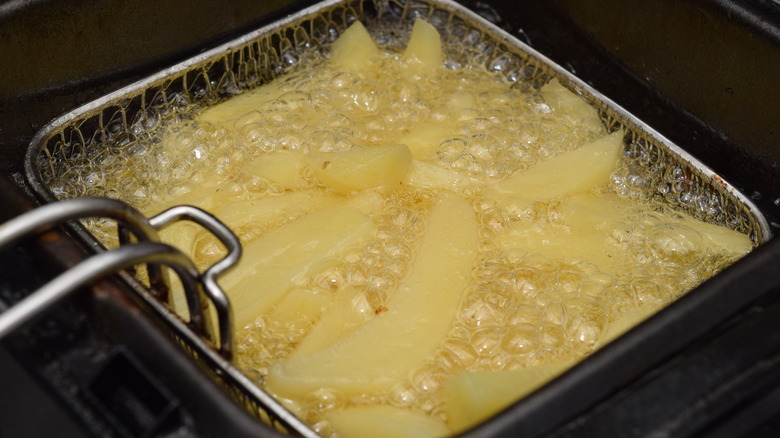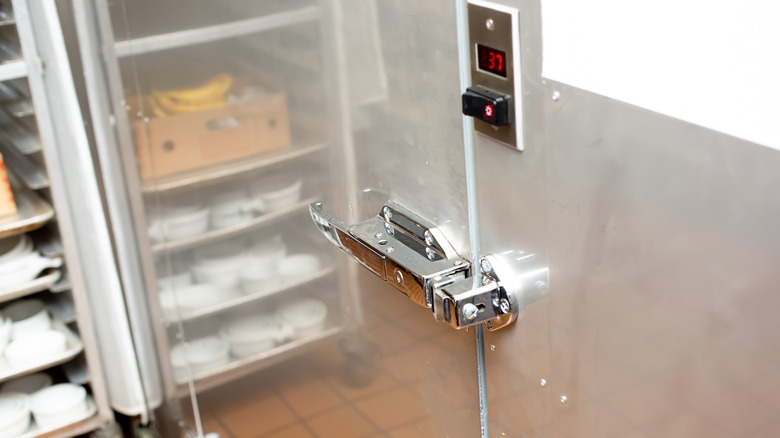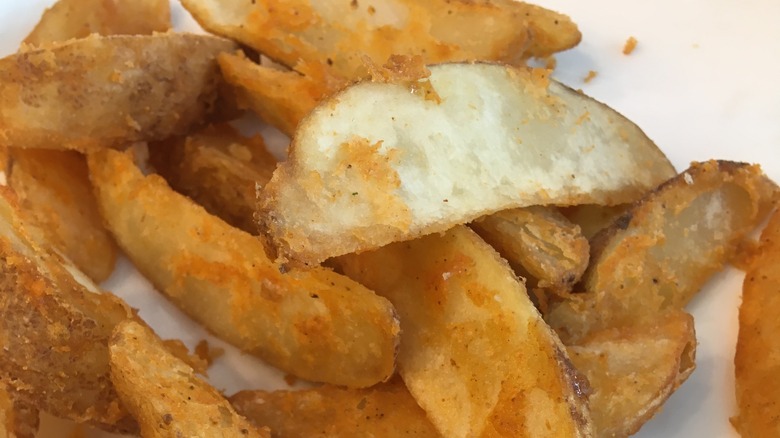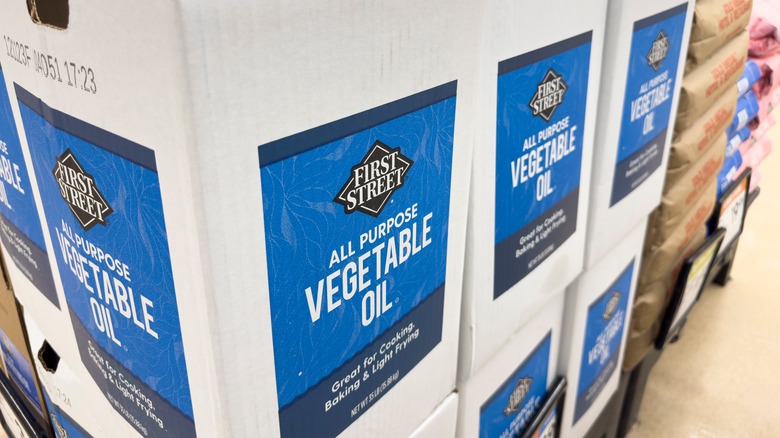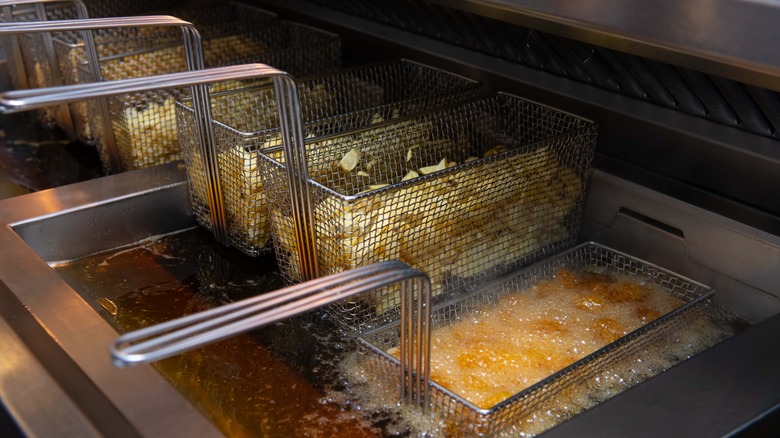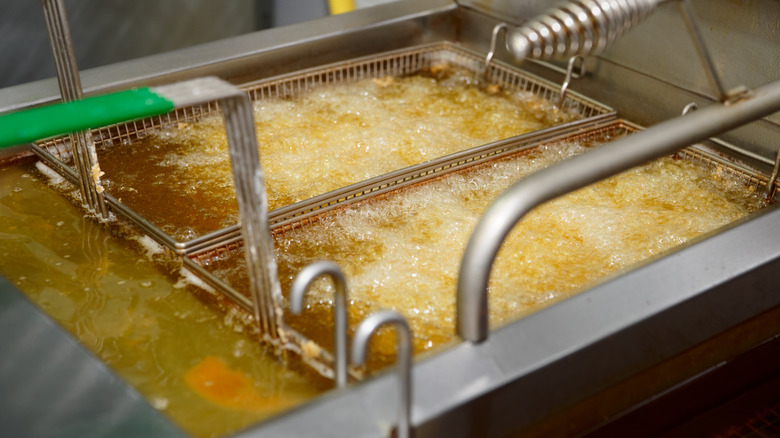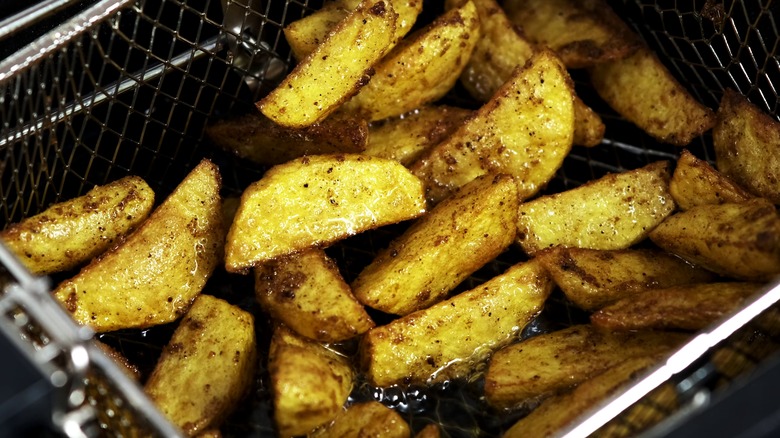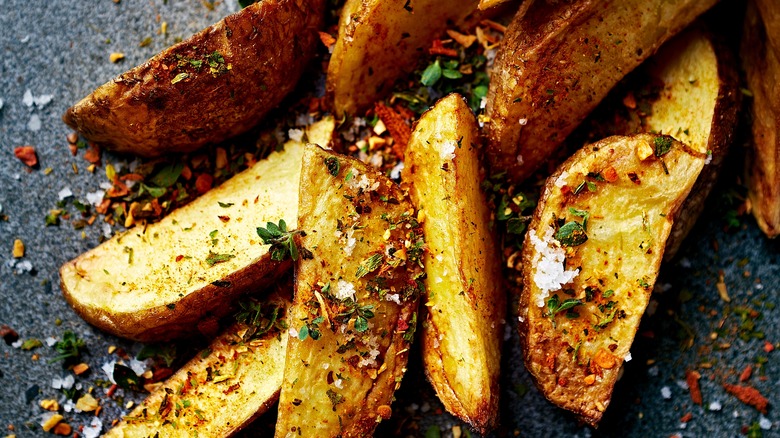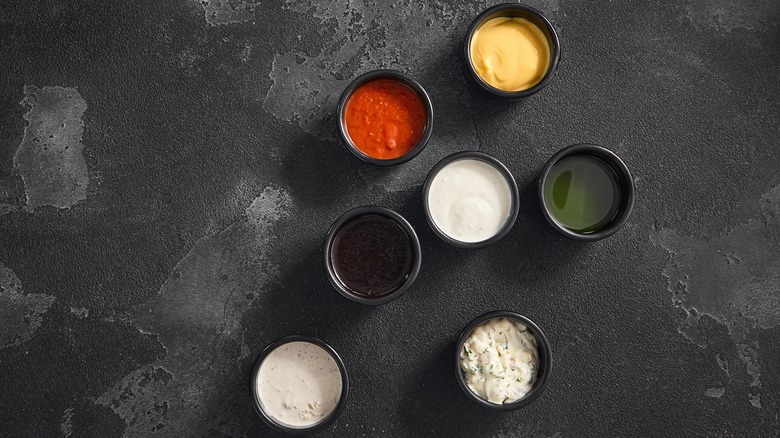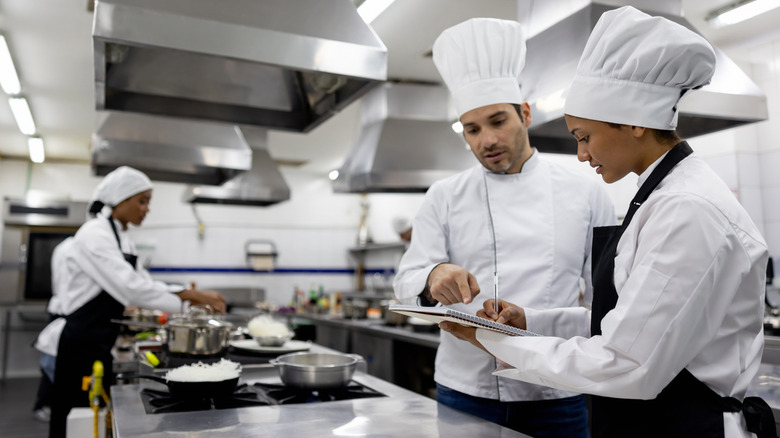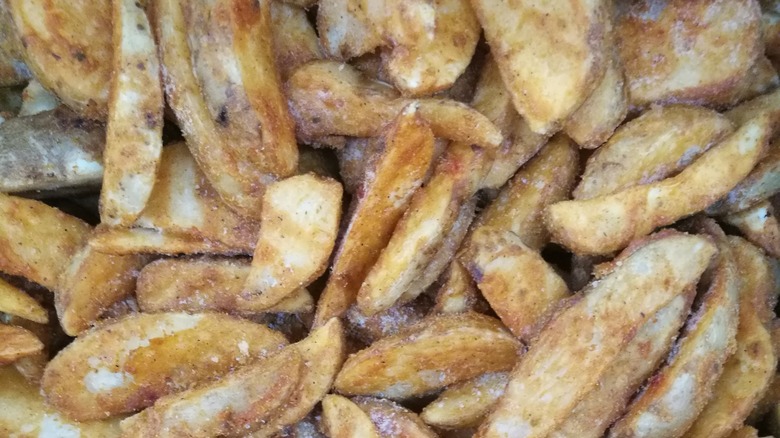An Expert Explains Why Potato Wedges Always Taste Better At A Restaurant
Out of all the different types of fries out there, potato wedges are one of my favorites. However, they always taste better at a restaurant than when I make them at home. Despite my best efforts, which include talking to professional chefs and line cooks, combing through recipes and food blog recommendations, and more, I still can't manage to make my potato wedges taste as good as the ones that come out of a professional kitchen. And there are quite a few reasons why. From not having an industrial deep fryer, to being less precise with knife cuts, to not using aged oil, there are lots of things that contribute to homemade potato wedges not measuring up to a restaurant's.
I spent 20 years working in the food service industry as an expo, host, bartender, and server. I worked in a couple of places that had potato wedges on the menu and was able to witness how they were made in great detail. As a result, several of the upcoming insights come from talking to and watching restaurant chefs. I gathered the rest of the professional cooking tips by exploring celebrity chef recommendations, food blogs, YouTube, and more. Keep reading to take a peek behind the curtain and discover all the reasons why potato wedges always taste better at a restaurant.
Restaurants use the ideal type of potato
There are more than 5,000 potato varieties worldwide, so most of us aren't familiar with all of them. How could we be? Even so, selecting the right potato for wedges is essential when it comes to achieving the ideal crispy exteriors and soft interiors this style of fry is known for. Restaurant chefs make sure to use the right potato for the recipe every time. As a result, their potato wedges have a better shot at being spectacular from the very start. However, I'll grab a particular type of potato because it has a nice color, seems to be the right size, or I just want to try something new. If you are like me, this may be one of the reasons restaurant potato wedges always taste better.
Potato wedges come in various sizes, so depending on a restaurant's particular recipe, you'll find they use different kinds of potatoes to make wedges. The restaurant I worked at used Russet potatoes. They are a classic, all-purpose potato that works great for making large wedges. They also seamlessly fit into various other recipes, so professional kitchens love them.
Gordon Ramsay is a big fan of frying floury potatoes like King Edwards because they have a dry, fluffy texture. They are ideal for wedges. In a YouTube video where Ramsay demonstrates slicing wedges you can see he is using Desiree potatoes, another variety perfectly suited to the job.
Professional chefs have superior knife skills and advanced slicing tools
Professional chefs and cooks spend countless hours honing their knife skills. As you can guess, this leads to superior precision and better accuracy in every cut. With potato wedges, these exact cuts are everything.
In one of Gordon Ramsay's YouTube videos, he shows us how to cut potato wedges like a pro. He starts by cutting them in half lengthwise. Then, he cuts each side in half, and each fourth in half, leaving him with eight perfectly shaped wedges. While demonstrating, he stresses that evenly cut potatoes cook evenly, so it's important to do it right. He also recommends leaving the skins on because they are full of flavor and help the wedges crisp nicely.
If your knife skills aren't the best, there's a quick and easy hack that might help you: Use an apple slicer to make perfectly cut wedges. Thanks to the accurately spaced blades, you get great wedges in one fell swoop. The most difficult part is lining up the middle of the slicer with the center of the potato.
Restaurants soak cut potatoes in water to release starch
After cutting potatoes into perfect wedges, restaurants soak them in a bath of cold water for several hours. Actually, they do this for fries too. Regardless, this simple step helps the potatoes release excess starch. As a result, they cook more evenly. In addition, it prevents the potatoes from developing sticky or gummy exteriors. Considering potato wedges are supposed to be crispy on the outside and soft in the middle, restaurants know they should never forgo soaking them before cooking.
In one of the restaurants I worked in, they soaked their cut potato wedges in large containers of iced water. The longer they sat, the cloudier the water became, so it was pretty obvious the technique worked. Typically, the cooks soaked the wedges overnight. However, if they were selling fast and we were about to run out, they would start pulling ones that had only soaked for about two hours and they still tasted great. I should know because I rarely went a shift without eating some.
Restaurants blanch their potatoes in oil before the final cook
Once potato wedges have been properly soaked in cold water, restaurants move forward by blanching them briefly in hot oil. Eventually, they'll be fired a second time before serving, but this initial deep fry helps them release excess moisture, which is crucial in creating perfectly crispy wedges. It also helps the wedges start building up a thicker exterior which assists them in achieving ideal results the second time around.
Partially cooking potato wedges in hot oil also helps restaurants serve them faster because it reduces the final cooking time. However, even if it didn't, I imagine they wouldn't skip this key step due to the delightfully crispy exteriors it produces.
If you've never tried double frying your potato wedges at home, it's likely that is one of the main reasons they don't turn out as good as if they came from a restaurant. It may seem like a lot of extra work, but once you give it a try you'll forget any hesitations you may have had about whether or not it is necessary. I know for a fact that every place I ever worked fried their potatoes twice, whether they were wedges or fries.
Restaurants allow potato wedges to cool after blanching -- prep work is key
After the first blanch in hot oil, restaurants typically spread potato wedges on a large sheet pan and place them in the fridge to cool. Giving them time to rest and cool allows them to crisp up beautifully when they are fried a second time. Simply frying them twice back-to-back won't lead to the same tasty results, at least according to a chef who told me so.
In restaurants, leaving batches of partially cooked, blanched potato wedges to cool serves two purposes. In addition to promoting crispiness, it also sets cooks up for success when orders start coming in at rapid speeds. Preparation is essential if the fryers and cooks are going to keep up in a fast-paced restaurant. At home, planning so far in advance doesn't always happen. So, if you are attempting to make a quick version of potato wedges and don't have time to let them cool for a couple of hours, this could potentially lead to less tasty results.
Many restaurants batter their wedges before frying
There are two approaches to making potato wedges crispy. The first is obviously cooking them properly. While this is done either way, the second approach involves dredging and battering them with a mix of flour and various seasonings before frying. If you've ever tried potato wedges from the grocery store deli or frozen section, they were most likely battered.
Many restaurants utilize batter as a way to infuse their potato wedges with bold seasonings and create the perfect crispy texture. Popular seasonings used in potato wedge batter include a blend of Cajun spices, or various peppers, like a mix of cayenne, paprika (which is dried bell pepper), black pepper, and chili powder. Personally, these are my favorite kinds of potato wedges. Restaurant cooks are pros at battering potatoes, but for a novice chef, it isn't always that easy to keep the batter intact. Unfortunately, this typically leads to wedges that aren't as good as your favorite restaurant's. Or, maybe you never thought about battering your potato wedges. If not, this is your sign to give it a try. Even if you don't nail it the first time, the added flavor and crunch will make it worth the additional effort.
Professional kitchens fry wedges in oil with a high smoke point
The type of oil you fry potato wedges in also matters. So, which oil should you use to fry potatoes? You have a few options, but most restaurants use vegetable oil. Not only is it inexpensive, but it also has a high smoke point, making it ideal for frying potatoes at a super high temperature. I've heard that some restaurants use peanut oil in their deep fryers, but due to the prevalence of peanut allergies, many places avoid it.
Duck fat is also used as a frying oil in some top-tier restaurants. When potatoes are fried in duck fat they become decadently rich and delicious. It gives them a distinct gourmet flavor that can't be mimicked with other oils. If you've ever tried duck fat-fried potato wedges you know what I mean.
Canola and safflower oil are also acceptable for use in a deep fryer. While I never worked at a place that used either of them, you could always try your luck with one at home. Maybe they'll help you achieve deeper, tastier flavored potato wedges.
Nothing compares to a restaurant's industrial deep fryer
The cooking method used to make potato wedges matters, and deep fryers are often best suited for the job (particularly in restaurants). You can easily buy a countertop deep fryer to up your homemade potato wedge game, but nothing compares to a restaurant's industrial deep fryer setup. These elaborate, high-grade appliances are specifically designed to handle high-volume restaurant kitchens. Unlike anything you'd normally have at home, they tackle large tasks efficiently and effectively.
Industrial restaurant deep fryers also reach super high temperatures, and they do it pretty quickly. The ability to reach extreme temperatures helps cook the outer layer of potato wedges to perfection. Your deep fryer at home probably can't keep up with a professional device. Unfortunately, what this means is that even if you follow all of the other techniques listed in this article, your homemade potato wedges may never be as good as the ones you get from a restaurant. That doesn't mean you should give up entirely — you may still get pretty close with a bit of practice and attention to detail.
Many restaurants fry potato wedges in aged oil
Something else that isn't as easy to recreate at home is aged oil, and restaurants have plenty of it. They fry an abundance of foods in their deep fryers for days without changing the cooking oil out for a fresh batch. As a result, lots of flavors build up within, which are then transferred to whatever goes in the oil next, including potato wedges. In addition, the molecules in oil change as it ages and this has the ability to affect the texture of foods. It can even lead to crispier, better tasting potato wedges in the end. If you don't deep fry a lot of foods at home, producing aged oil for your homemade potato wedges may not be in the cards, so you can add this to the growing list of reasons why they won't be as tasty as a restaurant's are.
In many of the restaurants I worked at the oil was changed weekly or bi-weekly. The new fresh oil was appealing, especially to a vegetarian like me because meat hadn't been fried in it yet. Even so, the fries and potato wedges that came out of this virgin oil didn't quite taste the same. In fact, some would say they weren't as flavorful. I still preferred them, but that's probably just because of my dietary preferences.
The pros also cook their potato wedges at two different temperatures
Professional chefs also fry their potato wedges at two different temperatures; lower the first time and higher the second. This may seem like just another pesky deep fryer detail, of which there are several when making wedges, but this variation in temperature further contributes to a restaurant's ability to serve the best tasting potatoes. If you strive for that level of excellence, overlooking this detail will only do you a disservice.
The first time restaurants fry potatoes it's at a lower temperature. Anywhere from 250 to 325 degrees Fahrenheit is typical. Cooking them a bit longer the first time is also recommended. That way, the second fry is quick and easy. The next time potato wedges get dropped in the deep fryer it's at a higher temperature, usually between 350 and 375 degrees Fahrenheit. If you are not practicing a double fry technique with different temperatures at home, your potato wedges are unlikely to turn into restaurant-quality potatoes.
When following all of the other restaurant tricks in this article, you don't need to worry about changing the fryer's temperature on a dime for the second round either. Your potato wedges need plenty of time to cool in the fridge before the final cook.
Restaurants take seasoning to the next level and apply it right after frying
Potatoes are not as flavorful as many other vegetables, so seasoning is key when it comes to making them super tasty. Restaurants season all of their potatoes generously, wedges included. Seriously, they use way more than you would probably expect. Often, they also go beyond a simple sprinkling of salt and pepper.
I worked at a spot that used a blend of parsley, onion powder, salt, and pepper on their wedges. You also had the option to order them tossed in garlic and parmesan. They were incredible. At another restaurant I worked at, the wedges were battered in a Cajun-style blend of seasonings. Spoiler alert — they were frozen, but more on that later. Still, the abundance of seasoning and flavor went a long way in making both restaurants's potato wedges delicious.
In addition to the type and amount of seasoning used, restaurants know seasoning potato wedges at the right time is key. When baking, they need to be seasoned before they go into the oven. However, if you are deep frying them, the seasoning doesn't go on until after they come out of the oil. Otherwise, all of the herbs and spices would fall off in the fryer, defeating the purpose of adding spices at all.
Don't underestimate the power of dipping sauces — many restaurants make their own
Thick, crispy potato wedges with soft, fluffy centers are perfect for dipping in a variety of sauces. They have lots of surface area for sauces to stick to and just about any dipping option is delicious with them. From ketchup to ranch to honey mustard to BBQ, potato wedges only get better when dipped into a tasty sauce. Quality restaurants know how much details like sauce matter, and many choose to make their own from scratch. While this does not directly change how potato wedges are made, it affects how they taste and how you enjoy them once a pile reaches your table.
If you aren't the kind of person to make homemade sauce, this could be one reason why your potato wedges don't rival a restaurant. Lucky for you, making homemade ketchup, ranch dressing, and other sauces is not super difficult. Give it a try and see how easily they improve all kinds of dishes, potato wedges included.
Restaurants have professionals cooking
I know I already talked about how professional cooks and chefs typically have better knife skills, but their expertise extends beyond that, no matter what they are making. In terms of potato wedges, you can expect a couple more of their finely-tuned chef skills to play a role in executing perfect potato wedges every time.
First, professional cooks know the importance of using timers. Typically, they are working on several cooking tasks simultaneously, so timers are essential in keeping each one on track. Home cooks may not feel like this is necessary if they have plenty of time to monitor progress along the way.
Second, professional cooks and chefs make potato wedges over and over again, and as we all know, practice makes perfect. Plus, restaurant chefs receive expert demonstrations with continual, personalized feedback on their work. If you are new to making potato wedges — and a pro has never shown you how — you can't really expect them to turn out as well as someone who has made them hundreds if not thousands of times.
Some spots even use frozen potato wedges
Quality restaurants don't typically use frozen foods, especially when it comes to their potatoes. However, some spots do opt for frozen fries and potato wedges. Whether this is because it cuts back on labor costs, they simply can't keep up with demand if made from scratch, or simply as a way to make things easier for cooks in a fast-paced kitchen, more restaurants serve frozen wedges than you might expect.
I worked in a busy sports bar across the street from a baseball stadium and its potato wedges were frozen. Admittedly, this place wasn't really focused on the food. It was mostly a place to drink before and after a game — therefore, food was not the main revenue generator. Even so, the potato wedges were not bad, especially after a couple of drinks. They weren't gourmet by any means, but they got the job done, and they may have even been better than some homemade options simply due to the industrial deep fryer and aged oil they were cooked in.

